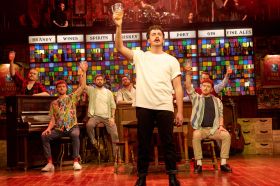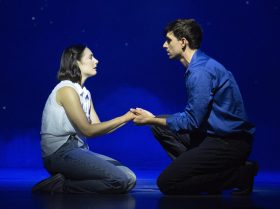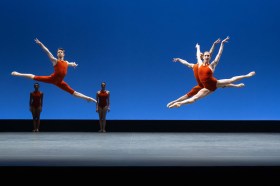Michael Moore transformed documentaries from an earnest, marginal genre of the birkenstock-wearing, tofu-eating, Body Shop-buying set into the agenda-setting core of popular culture. The success of Al Gore’s An Inconvenient Truth at the 2007 Academy Awards confirmed that popular culture and politics are merging in new and unpredictable ways.
One of the most stunning and unexpected success stories of popular music was caused by a documentary, Take That for the Record. Boy bands that pass their use-by date are like day-old cornflakes: stiff, pointless and difficult to remove. Take That was the template for boy bands. They sang and danced. They were cheeky and endlessly optimistic. This model ensured that they produced two of the highest selling albums of the 1990s: Everything Changes in 1993 and their Greatest Hits in 1996. Their fans exhibited a level of enthusiasm and passion that had not been seen since the Beatles.
Take That was mark(et)ed through their custard bowl haircuts, baggy trousers that could conceal the contents of a minibar and an over-scrubbed complexion derived from a severe Clearasil addiction. Each band member was granted a role in the pop drama, and a personality small enough to be swallowed with a spoon full of sugar. Gary Barlow, the self-deprecating songwriter, was mates with Jason Orange, the kind, animal lover. Mark Owen, the heart throb, was friends with Robbie Williams. Howard Donald was the silent one, with odd facial growths and a strange ponytail. Most thirteen-year-old girls and a few thirty year old men – Arena readers all – found them irresistible.
The early 1990s was the right moment for the Take That Template. The sharp revolutions in dance music at the time – initiated through acid house, trance, techno and jungle – pulsated through the lasers and fragmented the music charts. Dance culture did not abide by the rules of pop. The invisibility of producers, conducting an orchestra of samples, beats and basslines, did not fit the requirements of the music video age. Therefore, boy and girl bands were necessary. The facelessness of dance music was masked by the many faces of good looking men and women in vocal groups. They emphasized lyrics, had an identifiable verse, chorus and bridge structure and danced through safe and recognisable choreography. They were highly visual, compared to the hidden, quasi-legal, volatile and cold cut technology of post-acid house music. The vocal groups were television friendly and highly appropriate to the context of girl’s bedrooms, just as dance music was appropriate to warehouses, clubs and outdoor venues.
Take That served their puppet masters in the music industry well, perhaps too well. Inspiring hundreds of copy-cat boy bands, the original was no longer required. They called a press conference and – on February 13 1996 – ended the band. What was startling in this break up was the speed of the drop. Popular culture became unpopular culture. Within a few months, being an ex-member of Take That was a terminal illness. Robbie Williams, who left the organization early, went on to stellar success, propelled – appropriately – by his song ‘Angels.’ His battles with women, drugs and Noel Gallagher fed the celebrity-pyre. He was the right bad boy (with a heart of gold) for the right time (of shopping, excess and random confusions of the important and the banal). His explosive chart placings in 1999 and 2000 seemed unexpected, considering that his first solo album only sold 33,000 copies, compared to the multiple platinum power of Take That. After the ‘Angels’ breakthrough, the 1998 album I’ve Been Expecting You entered the chart at number one, and after one week became platinum. Similarly, the single ‘Millennium’ topped the charts. From 1999, Robbie Williams became a dominating solo performer, pushing other Thatters into the Andrew Ridgeley zone.
Gary Barlow, Jason Orange, Mark Owen and Howard Donald had suddenly become as relevant as sunscreen on a winter’s day. A former member of a boy band enters the revolving door of talk shows, reality television appearances and paparazzi set ups. There is a clinging desperation and morbid decay to this process. Ephemeral pop triggers rapid redundancy.
Then – suddenly and unexpectedly – a documentary was made to ‘celebrate’ ten years since the band’s demise. Take That for the Record was a sharp critique of fame and a way to understand the transitory nature of popular music. The stage was set to reveal the ruthless decline of Barlow, Orange, Owen and Donald. Dorian Grey’s portrait would be hung in front of cameras for all the former teenage screamers to see. Meanwhile, the success of Williams would be confirmed as he graciously agreed to be interviewed during his busy schedule.
The resultant footage was chilling. Howard Donald admitted that he had thought about suicide after the split, with Jason Orange realizing – on camera – that he had suffered with chronic insomnia. The onset coincided with the loss of the band. Mark Owen had withdrawn to a farm, a beautiful yet solitary man lost to time. Gary Barlow had battled obesity and loss of a record contract but managed to build a family and depart to a mansion filled with antiques. The cost of hyper-fame was written on their faces and left bullet holes through their lives. They had the scars of survivors. They had become decent men, battered by life and popular culture, but had become stronger and more complex. They had paid a price for fame, and continued to pay a price for the life they lived when fame evaporated. The footage was brutal, sharply cruel and cut-diamond cold, but also inspiring to see these old soldiers of pop.
Meanwhile, Robbie Williams’ interview included the documentary showed him to be a bitchy, ruthless man who had ‘beaten’ his former bandmates and reveled in the victory. The smugness, stupidity and glee with which he celebrated the failures of those with whom he had worked was not only uncomfortable to watch, but shredded his popular cultural persona. He was about to learn the lessons beaten into his former bandmates. The surprise was the speed of his fall.
And the speed of Take That’s rise. Williams looked like a prat. His four ex-bandmates were generous and soft in their admission of failure. After the documentary was shown on November 16, 2005, by November 25, Barlow, Orange, Owen and Donald called a press conference to announce that they were touring in 2006. This Ultimate Tour included thirty arena and stadium concerts and ran from April to June 2006. In the May, they signed a contract with Polydor Records. By the November, their single ‘Patience’ was released. It topped both the UK singles and the download charts, and was followed by their album Beautiful World that matched its success. They became the first band to top all five UK charts – for singles, albums, DVD, downloaded singles and downloaded album charts – in the same week. At the same time, Robbie Williams’ Rudebox could not match this success. The comparison was as riveting as a car crash.
Beautiful World is a stunning album. It is a work of regret, loss and the passing of time. While the first two singles are strong, actually the hidden treasures of the album are ‘Wooden Boat’ and ‘What you believe in.’ The former realizes that, “sometimes we don’t know what we’re waiting for. That’s the time to be the first one on the dancefloor.” The latter asks – with melancholic longing – “What am I to you, and what are you to me?” Almost every lyric can be read as a comment on celebrity and the costs and consequences of un/popular culture. Take That’s second breath of fame triggered a creativity tempered by experience, and a passion anchored to a frozen core of fear that it will not last.
An extraordinary documentary began a pop narrative of revival from the ashes of defeat. Even more remarkably, this doco-story had a fitting coda. Their first new release ‘Patience,’ won the best British Single on February 14, 2007. Williams received no awards on the night. A group of boys had become a band of men who learnt from life, lost fame, aged and still managed to reconnect with popular culture. When they released a song titled ‘Back for Good,’ they could never know that it would become an anthem for survival.




